The Paleogene Gosau Group Slope Basins of the Incipient Eastern Alpine Orogenic Wedge: A Case Study at the Gams Basin (Austria)
Abstract
:1. Introduction
2. Materials and Methods
3. Results
3.1. Biostratigraphy
3.2. Lithology, Petrology, and Sedimentology
3.2.1. Sedimentological Description of Sections
3.2.2. Thin Section Analysis
3.2.3. Heavy Mineral Analysis
4. Discussion
4.1. Classification of Sandy Turbidites of the Paleogene Upper Gosau Group of Gams
4.2. Provenance of the Paleogene Upper Gosau Group of Gams
4.3. A Model for the Slope Depositional System of the Gams Gosau Group
4.3.1. Depositional Model
4.3.2. Comparison with a Recent Analogue
4.3.3. Controlling Factors of Deposition in the Gams Basin
5. Conclusions
Supplementary Materials
Author Contributions
Funding
Data Availability Statement
Acknowledgments
Conflicts of Interest
Appendix A
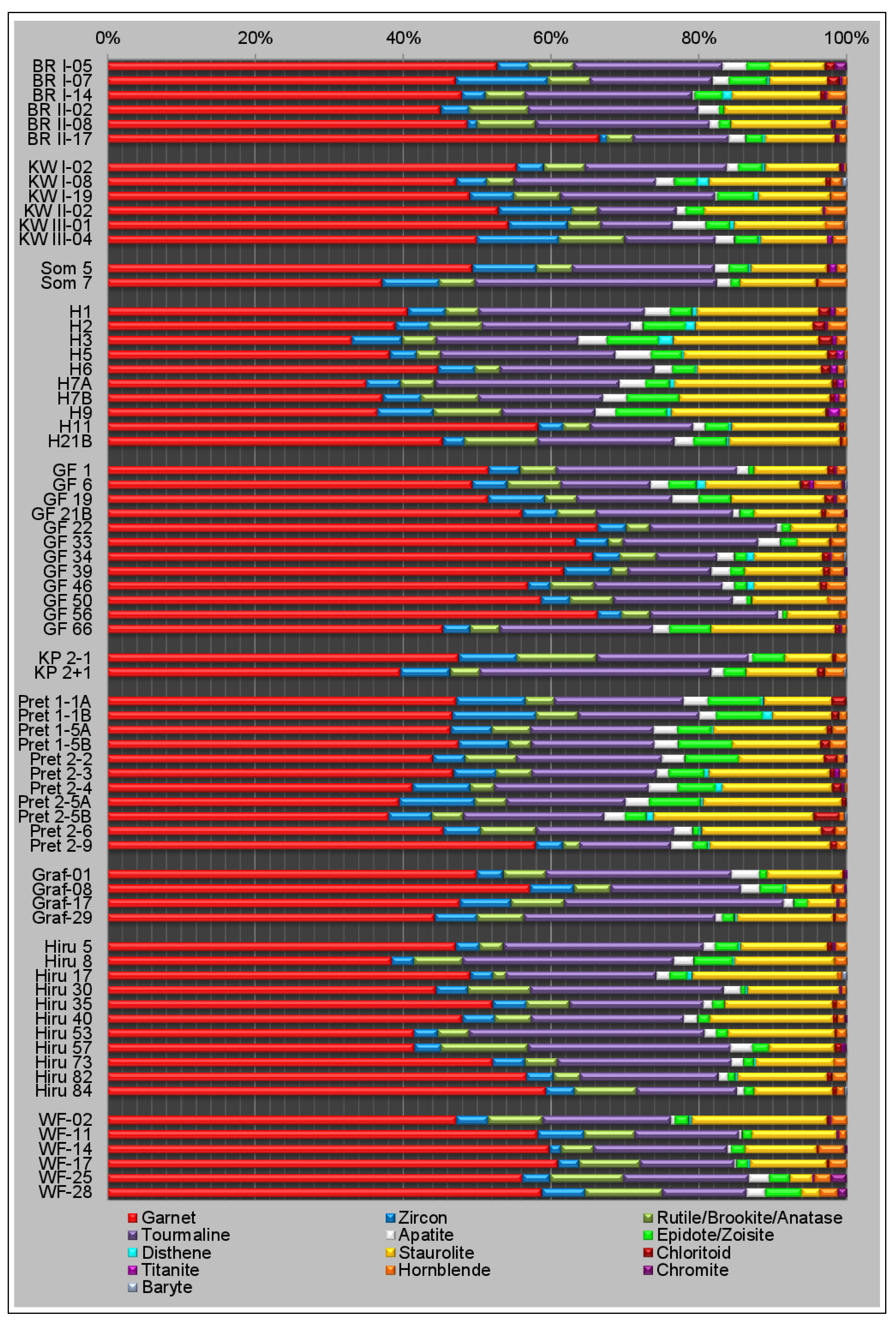
References
- Bouma, A.H. Sedimentology of Some Flysch Deposits: A Graphic Approach to Facies Interpretation, 1st ed.; Elsevier: Amsterdam, The Netherlands, 1962; 168p. [Google Scholar] [CrossRef]
- Walker, R.G. Turbidite sedimentary structures and their relationship to proximal and distal depositional environments. J. Sediment. Petrol. 1967, 37, 25–43. [Google Scholar] [CrossRef]
- Normark, W.R. Growth patterns of deep sea fans. Am. Assoc. Pet. Geol. Bull. 1970, 54, 2170–2195. [Google Scholar] [CrossRef]
- Haner, B.E. Morphology and sediments of Redondo Submarine Fan, southern California. Bull. Geol. Soc. Am. 1971, 82, 2413–2432. [Google Scholar] [CrossRef]
- Mutti, E.; Ricci Lucchi, F. Le torbiditi dell’Appennino settentrionale: Introduzione all’analisi de facies. Mem. Soc. Geol. Ital. 1972, 11, 161–199. [Google Scholar]
- Walker, R.G. Deep-Water Sandstone Facies and Ancient Submarine Fans: Models for Exploration for Stratigraphic Traps. Am. Assoc. Pet. Geol. Bull. 1978, 62, 239–263. [Google Scholar] [CrossRef]
- Normark, W.R.; Piper, D.J.; Hess, G.R. Distributary channels, sand lobes, and mesotopography of Navy Submarine Fan, California Borderland, with applications to ancient fan sediments. Sedimentology 1979, 26, 749–774. [Google Scholar] [CrossRef]
- Stow, D.A.V. Deep-sea clastics: Where are we and where are we going? In Sedimentology: Recent Developments and Applied Aspects, 1st ed.; Brenchley, P.J., Williams, B.P.J., Eds.; Geological Society: London, UK, 1985; Volume 18, pp. 67–93. [Google Scholar] [CrossRef]
- Stow, D.A.V. Deep clastic seas. In Sedimentary Environments: Processes, Facies and Stratigraphy, 3rd ed.; Reading, H.G., Ed.; Wiley-Blackwell: Oxford, UK, 1996; pp. 399–444. [Google Scholar]
- Pickering, K.T.; Stow, D.A.V.; Watson, M.P.; Hiscott, R.N. Deep-water facies, processes and models: A review and classification scheme for modern and ancient sediments. Earth Sci. Rev. 1986, 23, 75–174. [Google Scholar] [CrossRef]
- Pickering, K.T.; Hiscott, R.N.; Hein, F.J. Deep Marine Environments: Clastic Sedimentation and Tectonics, 1st ed.; Unwin Hyman: London, UK, 1989; 416p. [Google Scholar] [CrossRef]
- Mutti, E.; Normark, W.R. Comparing Examples of Modern and Ancient Turbidite Systems: Problems and Concepts. In Marine Clastic Sedimentology: Concepts and Case Studies, 1st ed.; Leggett, J.K., Zuffa, G.G., Eds.; Springer: Dordrecht, The Netherlands, 1987; pp. 1–38. [Google Scholar] [CrossRef]
- Mutti, E.; Normark, W.R. An Integrated Approach to the Study of Turbidite Systems. In Seismic Facies and Sedimentary Processes of Submarine Fans and Turbidite Systems, 1st ed.; Weimer, P., Link, M.H., Eds.; Springer: New York, NY, USA, 1991; pp. 75–106. [Google Scholar] [CrossRef]
- Reading, H.G.; Richards, M. Turbidite Systems in Deep-Water Basin Margins Classified by Grain Size and Feeder System. Am. Assoc. Pet. Geol. Bull. 1994, 78, 792–822. [Google Scholar] [CrossRef]
- Bouma, A.H. Key controls on the characteristics of turbidite systems. In Confined Turbidite Systems, 1st ed.; Lomas, S.A., Joesph, P., Eds.; Geological Society: London, UK, 2004; Volume 222, pp. 9–22. [Google Scholar] [CrossRef]
- Prather, B.E. Controls on reservoir distribution, architecture and stratigraphic trapping in slope settings. Mar. Pet. Geol. 2003, 20, 529–545. [Google Scholar] [CrossRef]
- Piper, D.J.W.; Normark, W.R. Sandy Fans-From Amazon to Hueneme and Beyond. AAPG Bull. 2001, 85, 1407–1438. [Google Scholar] [CrossRef]
- Stow, D.A.V.; Mayall, M. Deep-water sedimentary systems: New models for the 21st century. Mar. Pet. Geol. 2000, 17, 125–135. [Google Scholar] [CrossRef]
- Wagreich, M. Paleocene—Eocene paleogeography of the Northern Calcareous Alps (Gosau Group, Austria). In Paleogene of the Eastern Alps; Piller, W.E., Rasser, M.W., Eds.; Österr. Akad. Wiss., Schriftenr. Erdwiss. Komm 14: Vienna, Austria, 2001; pp. 57–75. [Google Scholar]
- Wagreich, M. Subcrustal tectonic erosion in orogenic belts- A model for the Late Cretaceous subsidence of the Northern Calcareous Alps (Austria). Geology 1993, 21, 941–944. [Google Scholar] [CrossRef]
- Wagreich, M. Subduction tectonic erosion and Late Cretaceous subsidence along the northern Austroalpine margin (Eastern Alps, Austria). Tectonophysics 1995, 242, 63–78. [Google Scholar] [CrossRef]
- Egger, H.; Rögl, F.; Wagreich, M. Biostratigraphy and facies of Paleogene deep-water deposits at Gams (Gosau Group, Austria). Ann. Naturhist. Mus. Wien 2004, 106, 281–307. [Google Scholar]
- Wagreich, M.; Faupl, P. Palaeogeography and geodynamic evolution of the Gosau Group of the Northern Calcareous Alps (Late Cretaceous, Eastern Alps, Austria). Palaeogeogr. Palaeoclimatol. Palaeoecol. 1994, 110, 235–254. [Google Scholar] [CrossRef]
- Wagreich, M.; Kollmann, H.A.; Egger, H.; Grachev, A.F.; Summesberger, H. Excursion Guide to RECCCE Workshop. In Rapid Environmental/Climate Changes and Catastrophic Events in Late Cretaceous and Early Paleogene. RECCCE Workshop Abstracts and Excursion Guide; Wagreich, M., Ed.; Geologische Bundesanstalt: Vienna, Austria, 2009; Ber. d. Geol. B.-A.; Volume 78, pp. 49–63. [Google Scholar]
- Wicher, C.A.; Bettenstaedt, F. Die Gosau-Schichten im Becken von Gams (Österreich) und die Foraminiferengliederung der höheren Oberkreide in der Tethys. PalZ Sonderh. Biostratigraphie Oberkreide 1956, 30, 87–136. [Google Scholar] [CrossRef]
- Kollmann, H.A. Zur stratigraphischen Gliederung der Gosauschichten von Gams. Mitt. Ges. Geol. Bergbaustud. 1963, 13, 189–212. [Google Scholar]
- Kollmann, H.A. Stratigraphie und Tektonik des des Gosaubeckens von Gams (Steiermark, Österreich). Jahrb. Der Geol. Bundesanst. 1964, 107, 71–159. [Google Scholar]
- Summesberger, H.; Wagreich, M.; Bryda, G. Upper Maastrichtian cephalopods and the correlation to calcareous nannoplankton and planktic foraminifera zones in the Gams Basin (Gosau Group; Styria, Austria). Ann. Naturhist. Mus. Wien 2009, 111, 159–182. [Google Scholar]
- Egger, H.; Wagreich, M. Upper Paleocene—Lower Eocene nannofossils from the Gosau Group of Gams/Styria (Austria). In Paleogene of the Eastern Alps; Piller, W.E., Rasser, M.W., Eds.; Österr. Akad. Wiss., Schriftenr. Erdwiss. Komm 14: Vienna, Austria, 2001; pp. 465–472. [Google Scholar]
- Stradner, H.; Eder, G.; Grass, F.; Lahodynsky, R.; Mauritsch, H.J.; Preisinger, A.; Rögl, F.; Surenian, R.; Zeissl, W.; Zobetz, E. New K/T sites in the Gosau formation of Austria. Terra Cogn. 1987, 7, 7. [Google Scholar]
- Lahodynsky, R. Geology of the K/T Boundary Site at Knappengraben Creek (Gams, Styria). In IGCP Project 199 "Rare Events in Geology": Abstracts of Lectures, Excursion Guide: Vienna, Austria, 12–17 September 1988; Ber. D. Geol. B.-A.: Vienna, Austria, 1988; Volume 15, pp. 33–36. [Google Scholar]
- Preisinger, A.; Stradner, H. Excursion Guide to the Cretaceous/Tertiary boundary site at Knappengraben, Gams (Styria). In Proceedings of the Abstracts and Program for the 52nd Annual Meeting of the Meteoritical Society; Vienna, Austria, 31 July–4 August 1989, LPI Contribution: Vienna, Austria, 1989; 282p. [Google Scholar]
- Egger, H.; Koeberl, C.; Wagreich, M.; Stradner, H. The Cretaceous-Paleogene (K/Pg) boundary at Gams, Austria: Nannoplankton stratigraphy and geochemistry of a bathyal northwestern Tethyan setting. Stratigraphy 2009, 6, 333–347. [Google Scholar]
- Wagreich, M.; Egger, H.; Gebhardt, H.; Mohammed, O.; Spötl, C.; Koukal, V.; Hobiger, G. A new expanded record of the Paleocene-Eocene transition in the Gosau Group of Gams (Eastern Alps, Austria). Ann. Naturhist. Mus. Wien 2011, 113, 35–65. [Google Scholar]
- Stradner, H.; Rögl, F. Microfauna and Nannoflora fo the Knappengraben Section (Austria) across the Cretaceous/Tertiary Boundary. In IGCP Project 199 "Rare Events in Geology": Abstracts of Lectures, Excursion Guide: Vienna, Austria 12–17 September 1988; Ber. d. Geol. B.-A.: Wien, Austria, 1988; Volume 15, pp. 25–26. [Google Scholar]
- Krenmayr, H.G. Die Nierental-Formation der Oberen Gosau-Gruppe (Oberkreide-Paleozän, Nördliche Kalkalpen) in Berchtesgaden: Definition, Fazies und Environment. Jahrb. Der Geol. Bundesanst. 1999, 141, 409–447. [Google Scholar]
- Punekar, J.; Keller, G.; Khozyem, H.M.; Adatte, T.; Font, E.; Spangenberg, J. A multi-proxy approach to decode the end-Cretaceous mass extinction. Palaeogeogr. Palaeoclimatol. Palaeoecol. 2016, 441, 116–136. [Google Scholar] [CrossRef] [Green Version]
- Basemap.at. Available online: https://basemap.at/ (accessed on 7 April 2017).
- Sinclair, H.D.; Tomasso, M. Depositional evolution of confined turbidite basins. J. Sediment. Res. 2002, 72, 451–456. [Google Scholar] [CrossRef]
- Normark, W.R.; Piper, D.J.W.; Hiscott, R.N. Sea level controls on the textural characteristics and depositional architecture of the Hueneme and associated submarine fan systems, Santa Monica Basin, California. Sedimentology 1998, 45, 53–70. [Google Scholar] [CrossRef]
- Normark, W.R.; Piper, D.J.W.; Sliter, R. Sea-level and tectonic control of middle to late Pleistocene turbidite systems in Santa Monica Basin, offshore California. Sedimentology 2006, 53, 867–897. [Google Scholar] [CrossRef]
- Romans, B.W.; Normark, W.R.; McGann, M.M.; Covault, J.A.; Graham, S.A. Coarse-grained sediment delivery and distribution in the Holocene Santa Monica Basin, California: Implications for evaluating source-to-sink flux at millennial time scales. Geol. Soc. Am. Bull. 2009, 121, 1394–1408. [Google Scholar] [CrossRef] [Green Version]
- Covault, J.A.; Romans, B.W. Growth patterns of deep-sea fans revisited: Turbidite-system morphology in confined basins, examples from the California Borderland. Mar. Geol. 2009, 265, 51–66. [Google Scholar] [CrossRef]
- Bown, P.R.; Young, J.R. Techiques. In Calcareous Nannofossil Biostratigraphy; Bown, P.R., Ed.; Kluwer Academic Publications: Dordrecht, The Netherlands, 1998; pp. 16–28. [Google Scholar]
- Martini, E. Standard Tertiary and Quaternary Calcareous Nannoplankton Zonation. In Proceedings of the 2nd International Conference on Planktonic Microfossils, Roma, Italy, 23–28 September 1970; pp. 737–785. [Google Scholar]
- Okada, H.; Bukry, D. Supplementary modification and introduction of code numbers to the low-latitude coccolith biostratigraphic zonation. Mar. Micropaleontol. 1980, 5, 321–325. [Google Scholar] [CrossRef]
- Aubry, M.-P.; Salem, R. The Dababiya Core: A window into Paleocene to Early Eocene depositional history in Egypt based on coccolith stratigraphy. Newsl. Stratigr. 2012, 9, 287–346. [Google Scholar]
- Agnini, C.; Fornaciari, E.; Raffi, I.; Catanzariti, R.; Pälike, H.; Backman, J.; Rio, D. Biozonation and Biochronology of Paleogene Calcareous Nannofossils from low and middle latitudes. Newsl. Stratigr. 2014, 47, 131–181. [Google Scholar] [CrossRef]
- Boenigk, W. Schwermineralanalyse, 1st ed.; Enke: Stuttgart, Germany, 1983; 158p. [Google Scholar] [CrossRef]
- Dickson, J.A.D. Carbonate identification and genesis as revealed by staining. J. Sediment. Petrol. 1966, 36, 491–505. [Google Scholar] [CrossRef]
- Koukal, V. Paleogene Deep-Water Facies of the Upper Gosau Subgroup at Gams (Styria, Austria). Ph.D. Thesis, University of Vienna, Vienna, Austria, 2020. [Google Scholar]
- Folk, R.L. Petrology of Sedimentary Rocks; Hemphill’s: Austin, TX, USA, 1968. [Google Scholar]
- Stern, G.; Wagreich, M. Provenance of the Upper Cretaceous to Eocene Gosau Group around and beneath the Vienna Basin (Austria and Slovakia). Swiss J. Geosci. 2013, 106, 505–527. [Google Scholar] [CrossRef]
- Walker, R.G. Facies Models 8. Turbidites and Associated Coarse Clastic Deposits. In Facies Models; Walker, R.G., Ed.; Geological Association of Canada: St. John, NL, Canada, 1979; pp. 91–103. [Google Scholar] [CrossRef]
- Faupl, P.; Wagreich, M. Late Jurassic to Eocene Palaeogeography and Geodynamic Evolution of the Eastern Alps. Mitt. Österr. Geol. Ges. 2000, 92, 79–94. [Google Scholar]
- Woletz, G. Charakteristische Abfolgen der Schwermineralgehalte in Kreide- und Alttertiär-Schichten der nördlichen Ostalpen. Jahrb. Geol. B.-A. 1963, 106, 89–119. [Google Scholar]
- Hubert, J.F. A zircon—Tourmaline—Rutile maturity index and the interdependence of the composition of heavy mineral assemblages with the gross composition and texture of sandstones. J. Sediment. Petrol. 1962, 32, 440–450. [Google Scholar] [CrossRef]
- Garzanti, E.; Andò, S. Heavy mineral concentration in modern sands: Implications for Provenance Interpretation. In Heavy Minerals in Use; Mange, M.A., Wright, D.T., Eds.; Elsevier: Amsterdam, The Netherlands, 2007; Volume 58, pp. 517–545. [Google Scholar] [CrossRef]
- Pober, E.; Faupl, P. The chemistry of detrital chromian spinels and its implications for the geodynamic evolution of the Eastern Alps. Geol. Rdsch. 1988, 77, 641–670. [Google Scholar] [CrossRef]
- Mange, M.A.; Maurer, H.F.W. Heavy Minerals in Colour, 1st ed.; Springer: Dordrecht, The Netherlands, 1992. [Google Scholar] [CrossRef]
- Garzanti, E.; Andò, S.; Vezzoli, G. The Continental Crust as a Source of Sand (Southern Alps Cross Section, Northern Italy). J. Geol. 2006, 114, 533–554. [Google Scholar] [CrossRef]
- Garzanti, E.; Andò, S. Plate tectonics and heavy mineral suites of modern sands. In Heavy Minerals in Use; Mange, M.A., Wright, D.T., Eds.; Elsevier: Amsterdam, The Netherlands, 2007; Volume 58, pp. 741–763. [Google Scholar] [CrossRef]
- Schuster, R. Das eo-Alpine Ereignis in den Ostalpen: Plattentektonische Situation und interne Struktur des Ostalpinen Kristallins. In Brenner Arbeitstagung 2003 Trins im Gschnitztal, 1–5 September 2003: Geologische Kartenblätter 1:50.000 148 Brenner, 175 Sterzing; Rockenschaub, M., Ed.; Geologische Bundesanstalt: Vienna, Austria, 2003; pp. 141–159. [Google Scholar]
- Leeder, M.R. Sedimentology and Sedimentary Basins—From Turbulence to Tectonics, 2nd ed.; Wiley Blackwell: Oxford, UK, 2011; 768p. [Google Scholar]
- Schmid, S.; Fügenschuh, B.; Kissling, E.; Schuster, R. Tectonic map and overall architecture of the Alpine orogeny. Eclogae Geol. Helv. 2004, 97, 93–117. [Google Scholar] [CrossRef]
- Schuster, R.; Kurz, W.; Krenn, K.; Fritz, H. Introduction to the Geology of the Eastern Alps. Ber. Der Geol. Bundesanst. Wien 2013, 99, 121–133. [Google Scholar]
- Missoni, S.; Gawlick, H.-J. Evidence for Jurassic subduction from the Northern Calcareous Alps (Berchtesgaden; Austroalpine, Germany). Int. J. Earth Sci. 2011, 100, 1605–1631. [Google Scholar] [CrossRef]
- Missoni, S.; Gawlick, H.-J. Jurassic mountain building and Mesozoic-Cenozoic geodynamic evolution of the Northern Calcareous Alps as proven in the Berchtesgaden Alps (Germany). Facies 2011, 57, 137–186. [Google Scholar] [CrossRef]
- Knierzinger, W.; Wagreich, M.; Palzer-Khomenko, M.; Gier, S.; Meszar, M.; Lee, E.; Koukal, V.; Strauss, P. Provenance and palaeogeographic evolution of Lower Miocene sediments in the eastern North Alpine Foreland Basin. Swiss J. Geosci. 2019, 112, 269–286. [Google Scholar] [CrossRef]
- Wagreich, M. Sedimentologie und Beckenentwicklung des tieferen Abschnittes (Santon-Untercampan) der Gosauschichtgruppe von Gosau und Rußbach (Oberösterreich,—Salzburg). Jahrb. Der Geol. Bundesanst. 1988, 131, 663–685. [Google Scholar]
- Pyles, D.R.; Syvitski, J.P.M.; Slatt, R.M. Defining the concept of stratigraphic grade and applying it to stratal (reservoir) architecture and evolution of the slope-to-basin profile: An outcrop perspective. Mar. Pet. Geol. 2011, 28, 675–697. [Google Scholar] [CrossRef]
- Prather, B.E. Calibration and visualization of depositional process models for above-grade slopes: A case study from the Gulf of Mexico. Mar. Pet. Geol. 2000, 17, 619–638. [Google Scholar] [CrossRef]
- Smith, R. Silled sub-basins to connected tortuous corridors: Sediment distribution systems on topographically complex sub-aqueous slopes. In Confined Turbidite Systems; Lomas, S.A., Joseph, P., Eds.; Geological Society Special Publications: London, UK, 2004; Volume 222, pp. 23–43. [Google Scholar] [CrossRef]
- Faupl, P. Die Flyschfazies in der Gosau der Weyerer Bögen (Oberkreide, Nördliche Kalkalpen, Österreich). Jahrb. Der Geol. Bundesanst. 1983, 126, 219–244. [Google Scholar]
- Wagreich, M. Stratigrafie und Lithofazies der Branderfleck-Formation und der Gosau-Gruppe (Oberkreide) von Lilienfeld (ÖK 56 St. Pölten). In Arbeitstagung 2013 der Geologischen Bundesanstalt Geologie der Kartenblätter 55 Ober-Grafendorf und 56 St. Pölten, Melk 23–27 September 2013: Wolfgang Schnabel zum 75. Geburtstag gewidmet; Gebhardt, H., Ed.; GBA: Vienna, Austria, 2013; pp. 20–37. [Google Scholar]
- Normark, W.R.; Piper, D.J.W.; Romans, B.W.; Covault, J.A.; Dartnell, P.; Sliter, R.W. Submarine canyon and fan systems of the California Continental Borderland. In The Southern California Continental Borderland; Lee, H.J., Normark, W.R., Eds.; Geological Society of America: Boulder, CO, USA, 2009; Volume 454, pp. 141–168. [Google Scholar] [CrossRef] [Green Version]
- Scheibner, C.; Speijer, R.P. Late Paleocene-early Eocene Tethyan carbonate platform evolution—A response to long- and short-term paleoclimatic change. Earth-Sci. Rev. 2008, 90, 71–102. [Google Scholar] [CrossRef] [Green Version]
- Covault, J.A.; Graham, S.A. Submarine fans at all sea-level stands: Tectono-morphologic and climatic controls on terrigenous sediment delivery to the deep sea. Geology 2010, 38, 939–942. [Google Scholar] [CrossRef]
- Wei, E.A.; Homes, J.J.; Driscoll, N.W. Strike-Slip Transpressional Uplift Offshore San Onofre, California Inhibits Sediment Delivery to the Deep Sea. Front. Earth Sci. 2020, 8, 51. [Google Scholar] [CrossRef] [Green Version]
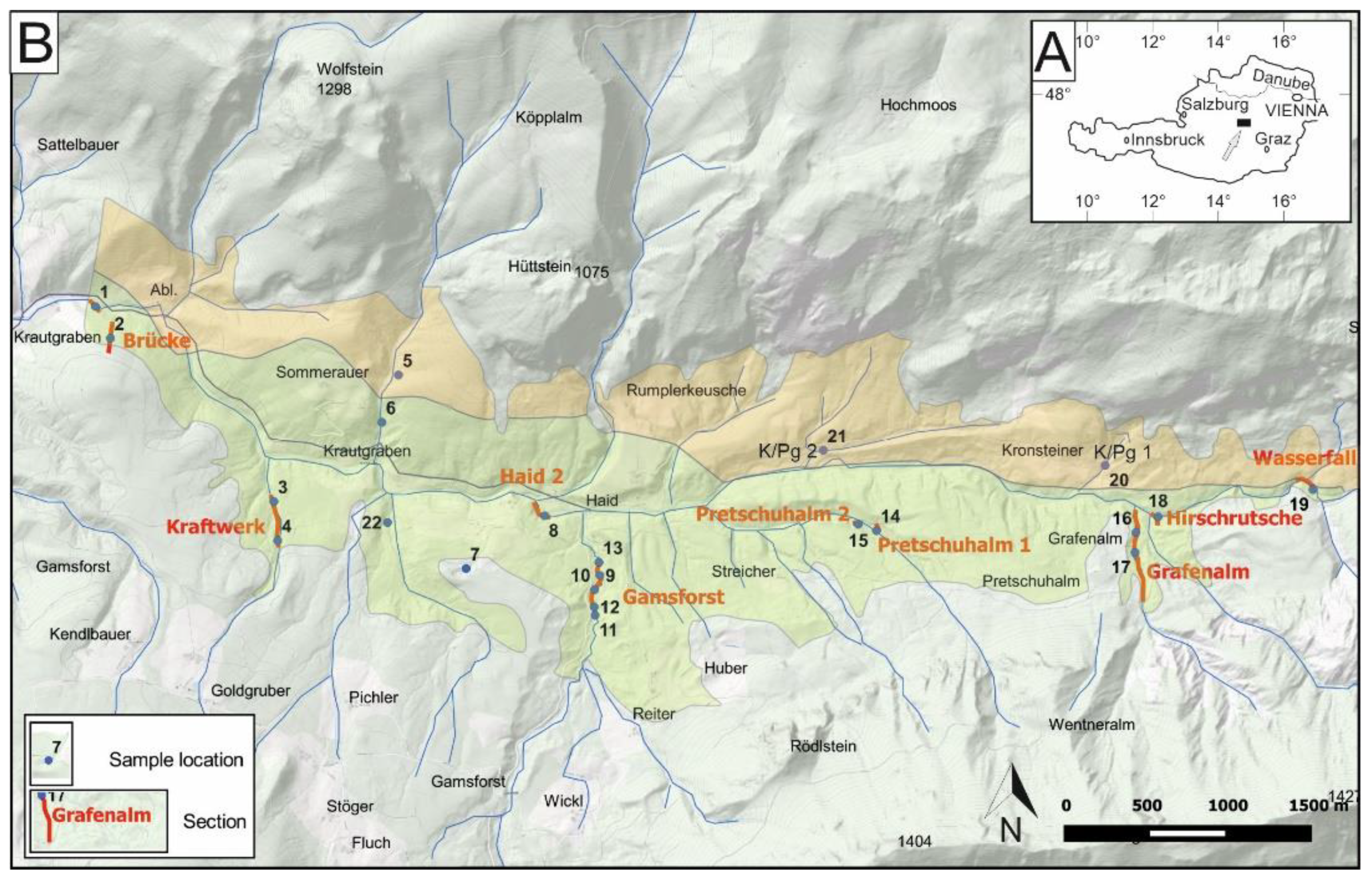
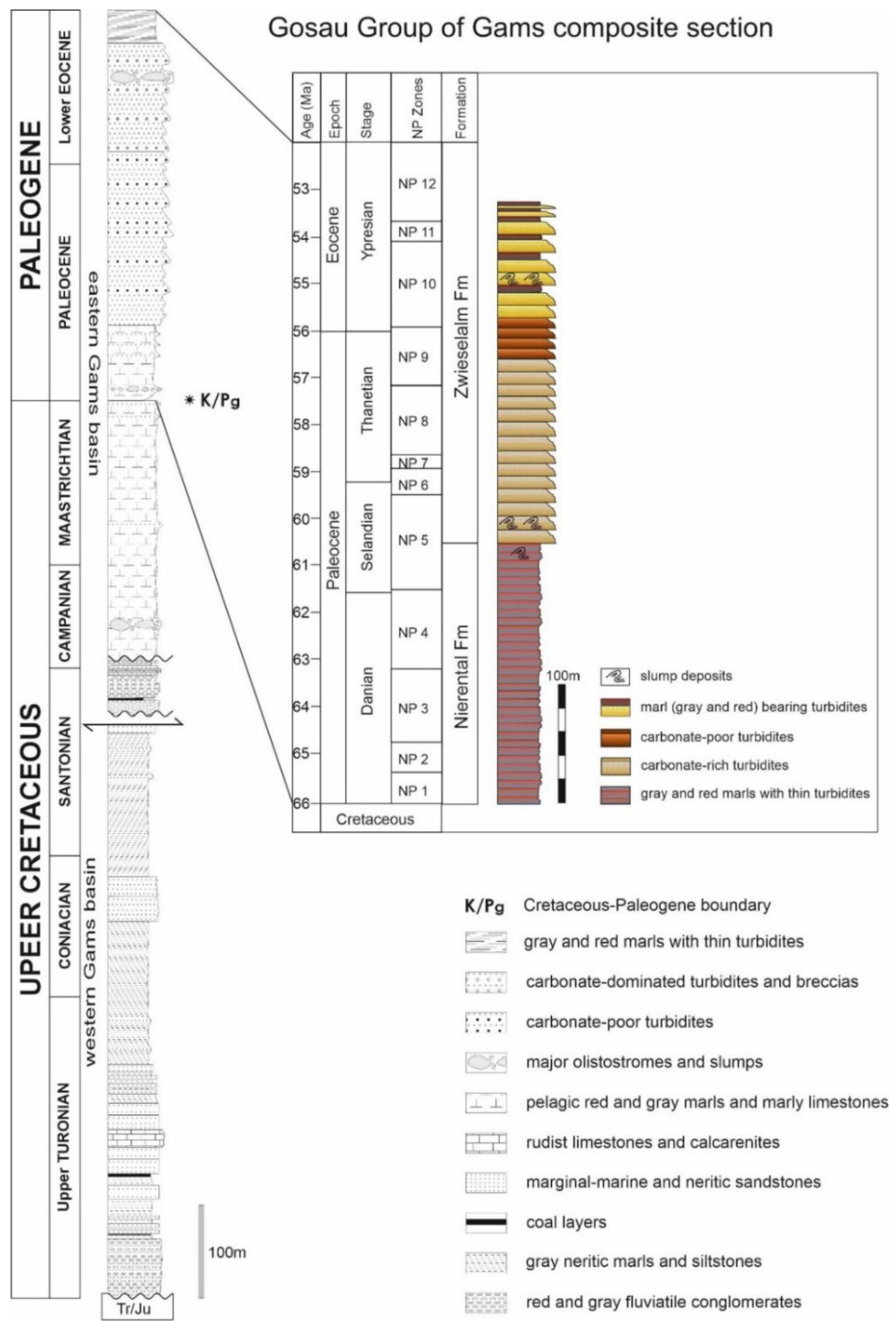
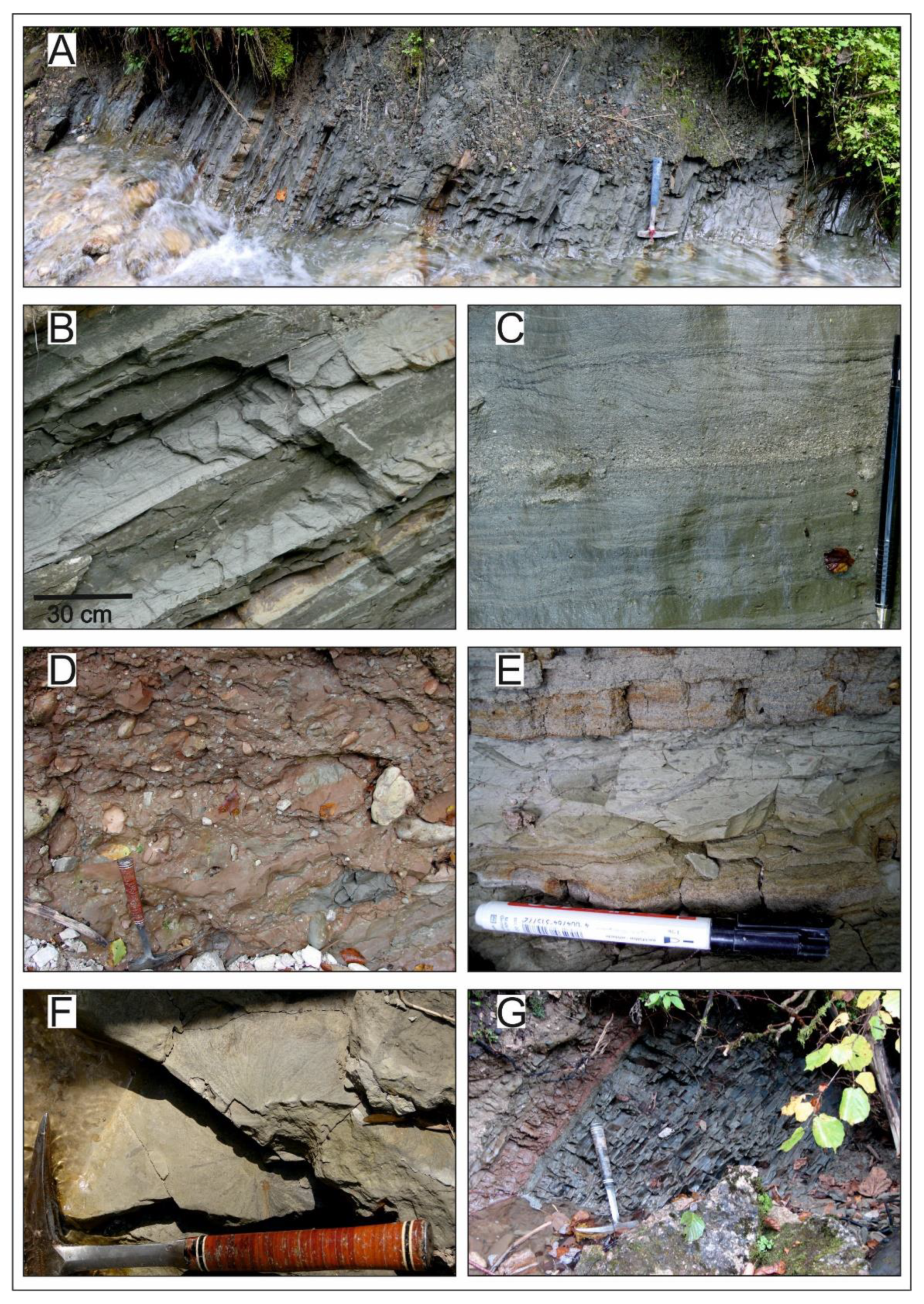
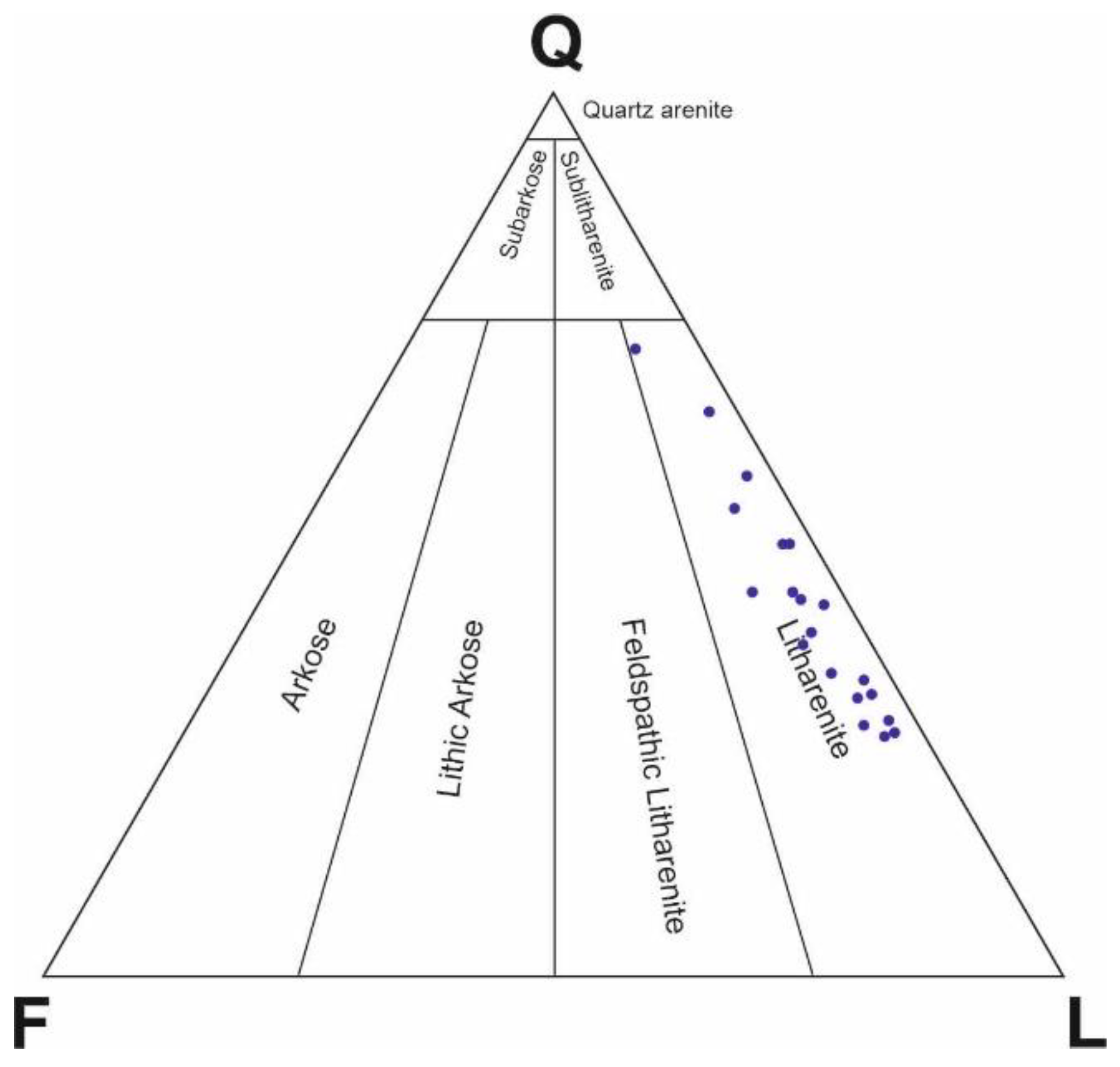

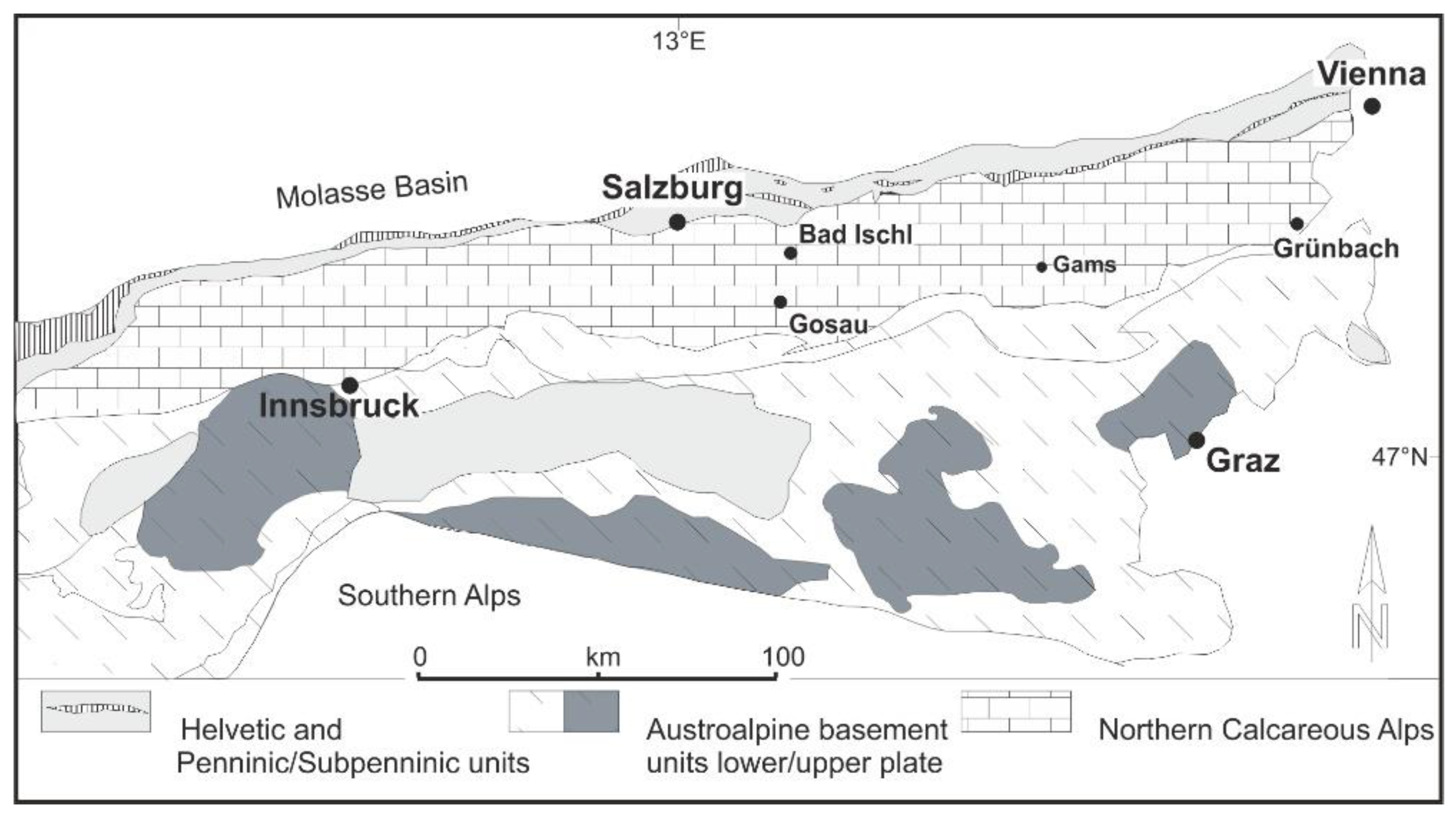
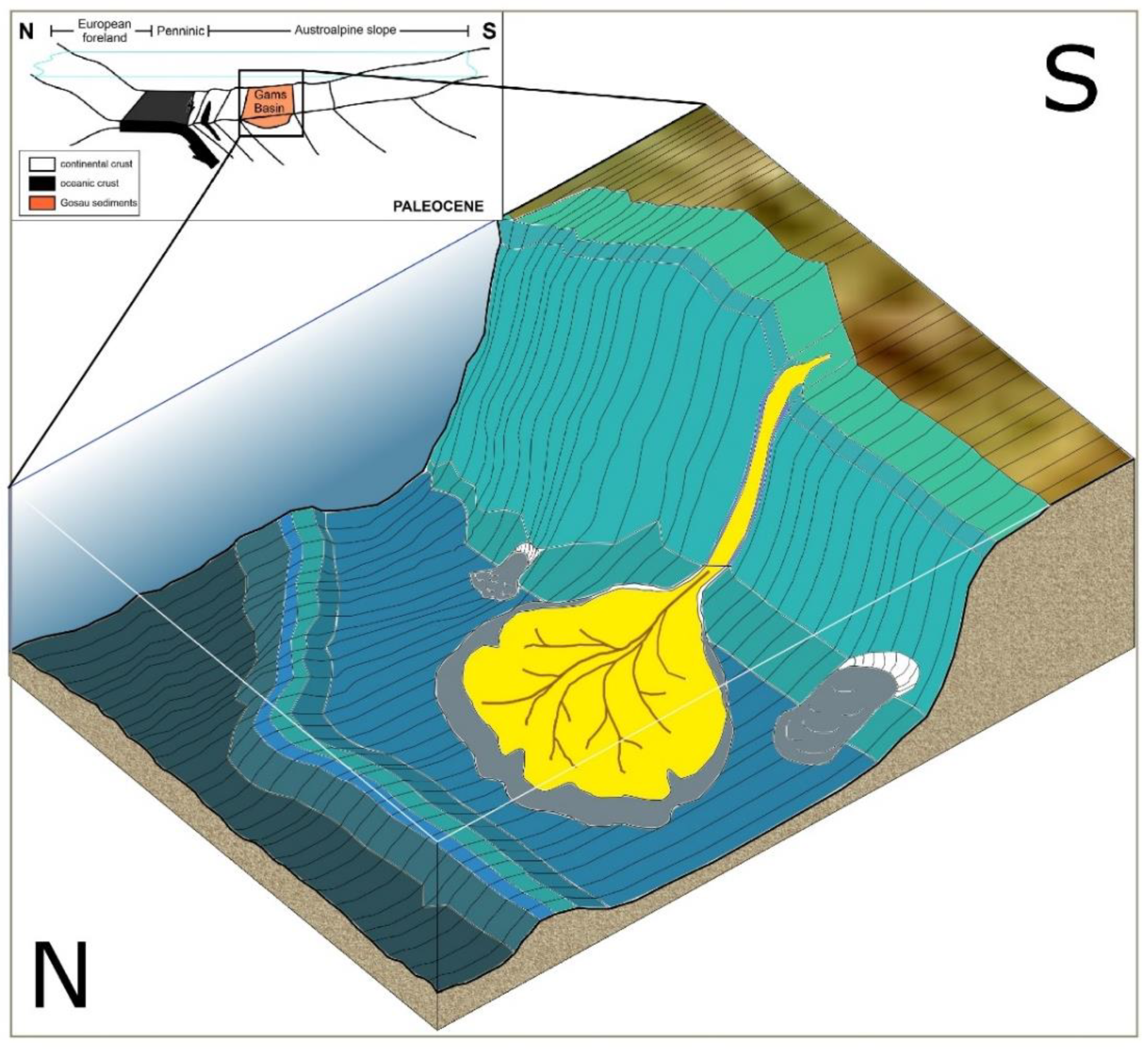
| Sandstone Grain Type | Composition/Texture | Mineralogy | Heavy Minerals | Source/Provenance Interpretation |
|---|---|---|---|---|
| Biogenic carbonate | Planktic and benthic foraminifera, red algae, bryozoa, echinodermata, peloids | Calcite | None | Small syndepositional biogenic buildups at southern margin of NCA |
| Carbonatic lithic gains | Cemented limestone and dolostone with various fossils/fossil fragments and grains | Calcite, dolomite | None | Reworked and redeposited Triassic, Jurassic, and Lower Cretaceous carbonate formations of the NCA |
| Mixed carbonate–siliciclastic lithic grains | Quartz, limestone, dolostone, biogenic carbonate fragments including Upper Cretaceous foraminifera | Quartz, calcite, dolomite, low amounts of feldspar | Cr, Zr, Ru, Tu, Ap | Reworked and redeposited Lower Gosau Subgroup rocks of the NCA |
| Silty shale and phyllite lithic grains | Shaly matrix with silt-sized grains | Clay minerals and small-sized mica, silt-sized quartz, minor silt-sized feldspar | None or silt-sized Zr, Ru, Tu, Ap | Anchimetamorphic to low-grade metamorphic rock fragments of GWZ and UAA |
| Lithic grains including quartzite, mica-quartz-schists, mica schists | Recrystallized texture of quartz | Quartz, mica, minor feldspar, | Gr (almandine), St, Ep, Tu, Zr | Low-grade to medium-grade quartz-rich metamorphic rock fragments of UAA |
| Platy lithic quarzite to gneiss grains | Strongly recrystallized texture of quartz | Quartz, mica, feldspar | Gr (almandine-pyrope), St, Ky, Ti | Higher-grade metamorphic rock units from UAA |
| Santa Monica Basin | Gams Basin |
|---|---|
| Terrigenous sediments | Terrigenous sediments plus biogenic carbonate material (NCA) |
| Small sandy turbidite system | Small sandy turbidite system |
| Mass movement deposits and slope failures common | Mass movement deposits (slumps, olistostromes) common |
| Supply via canyons and slope gullies | Supply via canyons and slope gullies (not preserved) |
| Depth about 1000 m | Deeper bathyal, approximately 2000 m |
| Canyon-fan system connected to rivers and littoral cell | Canyon and river system unknown (not preserved) |
| Sandy channel/muddy levee facies | Sandy channel/muddy levee facies |
| Primarily aggradation on fans | Progradation to aggradation |
| Insufficient volumes of sediment compared with available space | Insufficient volumes of sediment compared with available space |
| Deposition at all sea-level stages | Highstand/sustained system |
| Still active | Abandoned |
| Closed basin, bound and influenced by faults | Closed basin, bound and influenced by faults |
| Active continental margin | Active continental margin (Austroalpine microplate) |
| Strike-slip/transpressional regime | Strike-slip/transpressional regime |
| Narrow shelf | Narrow shelf |
Publisher’s Note: MDPI stays neutral with regard to jurisdictional claims in published maps and institutional affiliations. |
© 2022 by the authors. Licensee MDPI, Basel, Switzerland. This article is an open access article distributed under the terms and conditions of the Creative Commons Attribution (CC BY) license (https://creativecommons.org/licenses/by/4.0/).
Share and Cite
Koukal, V.; Wagreich, M.; Kallanxhi, M.-E.; Knierzinger, W. The Paleogene Gosau Group Slope Basins of the Incipient Eastern Alpine Orogenic Wedge: A Case Study at the Gams Basin (Austria). Minerals 2022, 12, 178. https://doi.org/10.3390/min12020178
Koukal V, Wagreich M, Kallanxhi M-E, Knierzinger W. The Paleogene Gosau Group Slope Basins of the Incipient Eastern Alpine Orogenic Wedge: A Case Study at the Gams Basin (Austria). Minerals. 2022; 12(2):178. https://doi.org/10.3390/min12020178
Chicago/Turabian StyleKoukal, Veronika, Michael Wagreich, Mădălina-Elena Kallanxhi, and Wolfgang Knierzinger. 2022. "The Paleogene Gosau Group Slope Basins of the Incipient Eastern Alpine Orogenic Wedge: A Case Study at the Gams Basin (Austria)" Minerals 12, no. 2: 178. https://doi.org/10.3390/min12020178
APA StyleKoukal, V., Wagreich, M., Kallanxhi, M.-E., & Knierzinger, W. (2022). The Paleogene Gosau Group Slope Basins of the Incipient Eastern Alpine Orogenic Wedge: A Case Study at the Gams Basin (Austria). Minerals, 12(2), 178. https://doi.org/10.3390/min12020178







